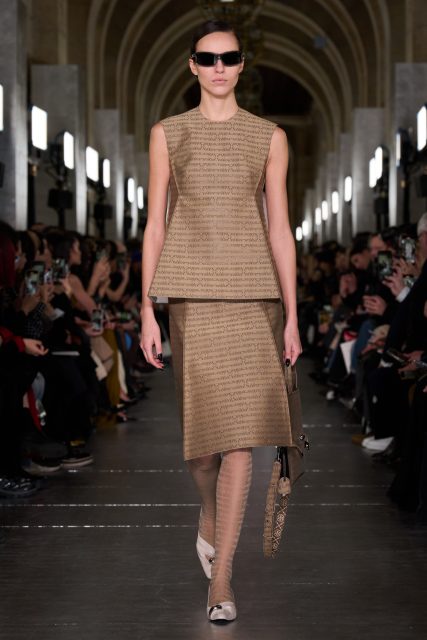After a season away, Thom Browne came back to New York Fashion Week and took up the closing spot in spectacular fashion. The last time he was on a runway was July, when he made his couture debut at the Opera Garnier in Paris in his trademark theatrical style. Today he was back at the Shed in Hudson Yards, where he last staged his own retelling of The Little Prince. This time around, it was Edgar Allen Poe’s 1845 poem The Raven that inspired his mise en scène: In a snowy yard a bare limbed tree dressed in a giant Thom Browne puffer coat stood guard, with a model animating its branches; behind it was a lit window with a broken pane through which the other models emerged.
Browne’s shows are as much about theater as they are about showcasing his latest clothes. In Poe’s poem, a grieving student is visited by a raven who answers all his questions about his lost love Lenore with the same word: “nevermore.” It’s a story about loss and despair told in the most musical of language: “That one word, as if his soul in that one word he did outpour.”
At a showroom visit ahead of his show, Browne was asked if perhaps he’s tormented like The Raven’s protagonist, and laughed it off. “I grew up loving Edgar Allen Poe,” he said, “and also, I do always like for people to see that I’m an American designer.” Carrie Coon, The Gilded Age’s Bertha Russell, narrated the poem, which added an element of drama to the show that Browne’s previous outings haven’t always had, her delivery shifting as she read, from calm to quite agitated, until it edged into full-blown hysteria.
The poem gave Browne his visual language for fall. A white moiré coat was boldly intarsia’d with flying black birds, and a pair of boxy jackets were graffiti’d with the raven’s catchphrase in block letters on the back. The models wore net headpieces whose profiles resemble that of the bird, and their nails were painted black and shaped into talons.
But Browne took great liberties. The ravens were joined by bugs, some in the formal tailoring of the 1910s (the illustrations of Georges Goursat, aka Sem, were inspirational) that were segmented horizontally like an insect’s body, and others more sculptural with the top layers peeling off the shoulders to reveal the underlayer, as if in the process of molting. Kafka’s Gregor Samsa came to mind.
As for the roses, some quick Googling revealed that starting in the 1930s an unidentified person that the media dubbed Poe Toaster used to visit the cenotaph that marked Poe’s original grave in Baltimore, Maryland, annually on his birthday, poured himself a glass of cognac and left three roses on the monument, along with the bottle of liquor, before departing. Whether or not there’s a connection there, the roses and the ravens will be ripe for the taking ahead of the Met Gala, whose “Sleeping Beauties” theme is connected to nature.
The references are less important to Browne than the process and the results, which were rather magnificent while remaining more real-world wearable than some of his other collections. “It’s really about focusing on the techniques that I used for July in Paris,” he said. Homegrown couture.
Editor
Nicole PhelpsCredit
Lead image: Daniele Oberrauch / Gorunway.com

